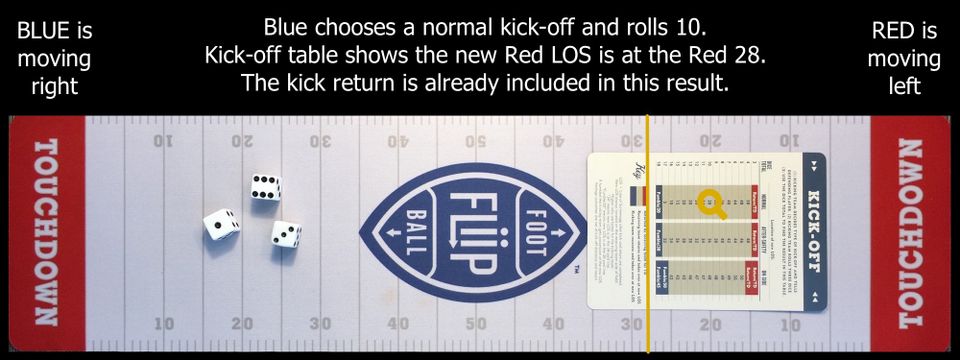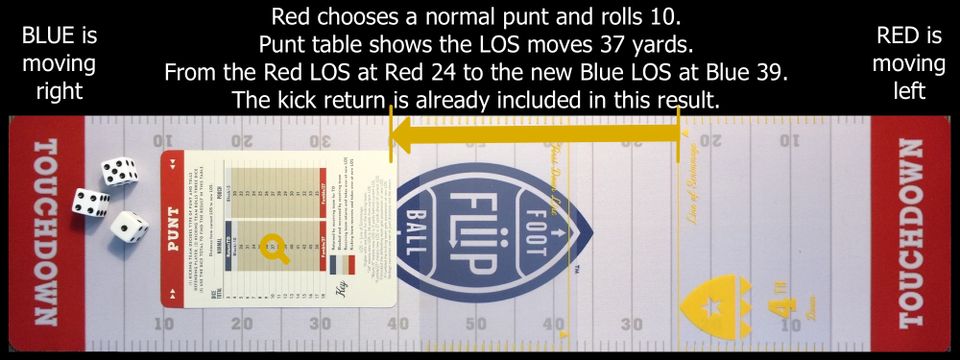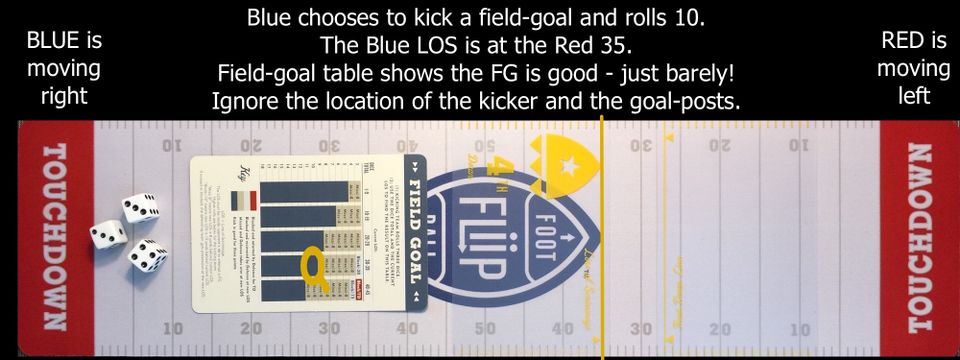Calling a Play
The video below is an example of a single play call using the standard rules and without skills. The players are secretly picking their plays before placing them face-down, Fliipping them over to see the play outcome, and marking the down-and-distance.
We show the play-cards being placed on the field for the convenience of this video. You can place your play-cards on the field safely away from the down-and-distance markers, or on the table next to the field if you prefer.
Game-Play
This video is an example of RedBlue game-play using the standard rules (no Skills). It spans two possessions per side and includes kick-off, punt, and field-goal examples.
The players are secretly picking their plays before placing them face-down. For the convenience of this video we show the dice being rolled and the play-cards being placed on the field safely away from the down-and-distance markers. You can also Fliip the play-cards and roll the dice on the table next to the field if you prefer.
The pacing of this video is close to the pace of actual game-play. This game is designed for quick easy fun and so a brisk pace should develop.
Special Teams
KICK-OFF
The example below shows how to use the kick-off table. The table shows the new LOS for the kicking team and includes the kick return. The receiving team takes over possession at the new LOS indicated by the table.
Roll the dice on the table next to the field if you prefer, especially if you don't want to accidentally move the down-and-distance markers.

PUNT
The example below shows how to use the punt table. The table shows the distance from the old LOS to the new LOS and includes the kick return. The receiving team takes over possession at the new LOS. Ignore the location of the punter.
Roll the dice on the table next to the field if you prefer, especially if you don't want to accidentally move the down-and-distance markers.

FIELD-GOAL
The example below shows how to use the field-goal table. The table uses the dice roll and the current LOS to determine if the kick is good. Ignore the location of the kicker and the goal posts.
Roll the dice on the table next to the field if you prefer, especially if you don't want to accidentally move the down-and-distance markers.

FAQs(General)
Q: Can I look at my play cards before I pick them and place them on the field?
A: Yes. Look at your play cards and decide which play you want to run, secretly pick that play card, and place it face-down on the field or table. If you are on defense you will get to see the offense's personnel before you pick your play since it is printed on the back of the cards. The players do not see each others cards until they are flipped over.
Q: Since we are using cards is there a discard pile or draw stack, or does someone need to deal the cards?
A: No. There are no card-type rules. When you are on offense you can play any one of your 12 offense play cards? You can run the same play several times in a row if you want. The same applies when you are on defense.
Q: Do I have to keep my play cards in piles as shown on the Quick Start diagram?
A: No. You can hold them in your hands if you want. But only hold offense cards when you are on offense and hold defense cards when you are on defense. The piles are suggested as a way to organize your cards and facilitate a decision pattern of first picking the personnel and then picking a play card from the four in that personnel.
Q: When the OrangeGrey game-set comes out can we play orange versus blue, or grey versus red?
A: Yes, you can play any combination you want. While we have designed the specific pairings of RedBlue and OrangeGrey for great game-play, you can use other color pairings too. The Details section provides additional information on playing games with other color pairings.
FAQs(Play Calling)
Q: I can't decide which offense or defense play card to pick. How should I decide?
A: Try adopting the following styles for a simple easy game-plan.
- Use a conservative style on offense by picking conservative plays about 75% of the time. Mix in all personnel and an even split of runs and passes.
- Use a personnel matching style on defense by picking Run-Stop personnel when the offense is in Power, Base personnel when the offense is in Base, and Pass-Stop personnel when the offense is in Spread. Stay conservative most of the time and mix in various focus areas.
These are great ways to get started. You can switch to other styles as the game goes on and you react to the other player. Refer to the Game Plans
page for more details.
Q: Can I try to figure out the best defense play-card to use against a given offense personnel and always use that defense play?
A: You can try but it will not work. When your opponent on offense selects their play-card and places it face-down you will know their personnel but you will not know which of four possible plays they have selected. So for any given combination of offense personnel and a specific defense play-card there are four possible outcomes. Fliip is designed such that each set of four includes at least two outcomes which are good for the offense and at least one outcome which is good for the defense. If you always select a given defense play-card against a given offense personnel then the offense can counter by selecting the specific offense play-card which is most successful against your preferred defense play-card.
Similarly, for any given combination of a specific offense play-card and a given defense personnel
there are four possible outcomes. Fliip is designed such that each set of four includes at least two outcomes which are good for the offense and at least one outcome which is good for the defense.
Refer to the Coach's Clipboards found on the Extras section of this site for more information.
You can refer to the Pre-Snap Uncertainty
area found in the DETAILS section of this site for more information.
Q: Why not always select aggressive passes on offense since I could get a touchdown pass?
A: There is a balance of reward and risk. Each aggressive offense play-card has a chance to result in an instant TD but could also result in a turnover. Similarly, each aggressive defense play-card has a chance to result in a turnover but can also result in an instant TD.
Q: I picked a defense play-card which should be perfect against a given offense play-card but the outcome is still good for the offense. Why aren't all outcomes bad for the offense when I pick a great defense?
A: Fliip is designed to permit a range of outcomes from good to bad for each possible combination while matching statistics within the aggregate. So if you make a great defense personnel or play call you will do well in the aggregate but there are still a few outcomes that are good for the offense. Similarly, if you call an ill-suited defense personnel or play you will do poorly in the aggregate but there are still a few outcomes that are bad for the offense. We feel this matches real football which obviously does not have certainty of outcome for any given play but still produces aggregate outcomes that make sense on a relative basis.
For example, the conservative pass play "WR Slant" from the offense Spread personnel will gain on average 10 yards against Run-Stop, 8 yards against Base, and 4 yards against Pass-Stop defense personnel. So if you expect the offense to select this play then you will do best in the aggregate to use Pass-Stop defense personnel. However there still two good outcomes from this play for the offense against this personnel.
Similarly, the conservative run play "HB Off-Tackle" from the offense Base personnel will gain on average 3 yards against Run-Stop, 5 yards against Base, and 6 yards against Pass-Stop defense personnel. So if you expect the offense to select this play then you will do best in the aggregate to use Run-Stop defense personnel. However there are still two good outcomes from this play for the offense against this personnel.
Your choice of defense focus and aggressive-versus-conservative are also important to the play outcome along with your choice of personnel. Refer to the Coach's Clipboards
found in the Extras section of this site for more information.
Q: I got intercepted on my first few drives. How should I adjust?
A: Don't be too aggressive on offense until you get a feel for how the defense is playing. Start with one aggressive play for every three or four conservative plays and watch the defense.
Be careful about aggressive passes when you think the defense might be playing aggressive pass defense (or aggressive runs against aggressive run defenses). Page 7 of the 'Coaches Clipboard' shows plays to avoid these situations to reduce the odds of a turnover. If you notice that the defense just plays aggressive a lot then stick to mostly conservative plays and march down the field. Later on you can try an aggressive run play from your spread offense personnel (a somewhat unexpected play call) and you might run for a TD.
Another way of thinking about this situation is that match-ups of "irresistible force against immovable object" have a higher chance of a turnover than normal; particularly if the defense is aggressive. These match-ups are as follows:
- Aggressive runs in Power personnel against Run-Stop defense personnel.
- Aggressive passes in Spread personnel against Pass-Stop defense personnel.
These match-ups also include some very good yardage outcomes for the offense but do not include any immediate touchdowns. Mixing in unexpected plays (runs from Spread personnel and passes from Power personnel) will add the possibility of an immediate touchdown and discourage the defense from being aggressive.
Q: Why are the statistics in the game not exact
matches to the real statistics?
A: This is intentional as we've made a few adjustments to accommodate better and more balanced game-play. For example, the turnover rate is set higher than the real 2.4% statistic and at the immediate touchdown rate of 4.2%. This permits the balancing of risk and reward by pairing each immediate touchdown with a companion turnover. The game is as close as is reasonable to the real statistics while deferring to good game-play.
FAQs(Special Teams)
Q: Why are punts and field-goals measured from the line-of-scrimmage and not from where the kicker is actually standing?
A: It's just simpler this way. We have taken the stats for punts and field-goals and adjusted them to be measured from the line-of-scrimmage. This way all you have to do is keep track of the line-of-scrimmage to read result from the kick-tables.
Q: What happens if a punt lands in the opposing teams end-zone?
A: This is treated as a touch-back and the opposing team starts their possession at their 20 yard-line. If you think your punt could result in a touch-back you can consider a Pooch punt which will travel a shorter distance and potentially pin your opponent inside their 20 yard-line.
FAQs(Turnovers)
Q: It seems weird that if the receiving team fumbles a kick-off or punt return for that result should be counted as a possession by them.
A : A fumbled return is counted as a possession by the receiving team since they had to have possession during the return before it was fumbled. Also, this makes sure that possessions alternate back-and-forth between teams.
Q: When I get a turnover on defense shouldn't I return the ball the other direction?
A: No. There there are no returns beyond the outcome shown. The turnover outcomes on the aggressive defense play cards result in the defense taking possession at the spot indicated by the yardage outcome.
- “4 FUM” means the ball was fumbled after a 4 yard gain on a run play. Mark off a four yard gain in the direction the offense is facing and then the defense takes over possession from that point.
- “8 INT” means the ball was intercepted after an 8 yard completion (to a defender) on a pass play. Mark off an eight yard gain in the direction the offense is facing and then the defense takes over possession from that point.
Q: What happens if there is a fumble or interception in the end-zone?
A: It is always a turnover with possession going to the defense and with a new LOS at their 20 yard line.
An example for a fumble would be if the LOS is at the defense's 2 yard line and the outcome is "FUM 4". This means the fumble is recovered 2 yards inside the end-zone. The team on defense gets possession with the new LOS at their 20 yard line. We always assume that the fumble occurred before the ball crossed the goal-line and rolled forward into the end-zone.
An example for an interception would be if the LOS is at the defense's 5 yard line and the outcome is "INT 8". This means the pass is intercepted 3 yards inside the end-zone. The team on defense gets possession with the new LOS at their 20 yard line.
FAQs(Skills)
Q: The OrangeGrey advanced game-set includes Skills. Can I play games without Skills?
A: Yes! Just set the skills aside and use standard Fliip game-play. Call plays with the play-cards, use the kick-tables and dice for special teams, track the down-and-distance with the clear markers and DOWN token, and keep score on the score-pad.
Q: Can I use Skills wth RedBlue?
A: Yes! Skills are colorblind and work with Orange, Grey, Red, and Blue.
Q: How do Skills change the game-play?
Game and possession skills can change Fliip outcomes and play skills provide a brief specific impact. Otherwise the underlying game-play is the same. Each team will continue to use standard Fliip game-play with the skills altering the outcomes of the plays and kicks.
Q: What is the statistical impact of Skills?
A : Skills provide a modest benefit to the offense. Offense game skills reduce the probability of a turnover from 4% to 1% of all outcomes while defense game skills reduce the probability of an immediate touchdown from 4% to 2% of all outcomes. Offense possession skills add about a yard-and-a-half per play to all outcomes while defense possession skills reduce this by about one-half yard per play. Kicking play skills are equivalent to moving the kicker's location about 10-yards.
The planned YellowBlack expert expansion will shift the balance back towards the defense with special defense skills and play-cards.
Game Theory :)
This game involves science, math, thinking, and cruel luck. At first glance it might seem that it shares just one thing with football. But it is actually just like real life football except it is a lot smaller. It's just a matter of scale. Consider the cost of a modern stadium along with the combined salaries of the players and staff. Scale that down to how much you paid for this game and that's how you ended up with these cards. That's a lot of science to absorb so let's move on to the math.
The cards are designed using real statistics from real football. In some cases we have matched the real life numbers as closely as possible. And in some cases we have made adjustments to create better balance and game-play. In this way we have used both real not-funny and funny not-real math. So you should be covered up with numbers.
We tried to layer human behavior on top of all this science and math. The humans in this case are coaches and the behavior is thinking. These two are required for play calling but they absolutely do not want to be together. So we had to leave them out. You will have to act as coach and do your own thinking.
As coach and thinker you will have a number of responsibilities. First you will pick the play. After that you are done. Just kidding! You will be engaged in mental Kung Fu with the other coach. Try to read tendencies. Aggressive play calling can result in a touch-down, a turnover, a mid-season coaching change, or none of the above. Conservative play calling can result in none of the above, and other things not listed above.
In any case play calling is critical to the game. You will win or lose mostly because of how you pick your plays, and sometimes because of the kicker. Yes, this is the cruel luck part of the game. It always sneaks in just like real life.
